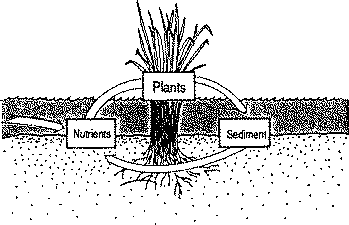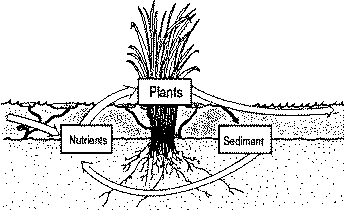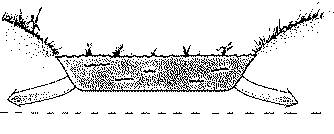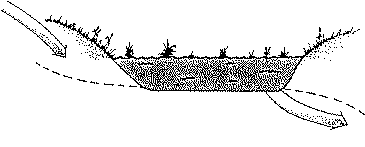Can Wetlands Filter Nutrients From Manure

WQ-ten
11/90
Wetlands and Water Quality
Brian G. Miller, Section of Forestry and Natural Resources
Wetlands one time made up 25 pct of Indiana. Many of these five.6 one thousand thousand acres were located in the fertile farmground of northern Indiana. Early in the 19th century, landowners began using open up ditches and tiles to bleed large areas of wetlands. They then converted the drained soil to agricultural production. Since then, nearly 86 pct of Indiana'due south wetlands have been drained or filled.
Wetlands are areas characterized by saturated or well-nigh saturated soils virtually of the year. Wetlands serve a number of important environmental functions. Location, soil type, surface and ground water movement determine which of the following functions a item wetland may serve.
Alluvion Water Memory
Usually located in depressions, wetlands receive surface runoff during storms. Water collects in these areas and contributes to stream flow when total or through basis water move. Wetlands act as a holding area for large quantities of surface h2o which can exist slowly released into a watershed. A one acre wetland, one foot deep, tin can hold approximately 330,000 gallons of water. When wetlands are removed, storm h2o runs direct into the watershed, increasing flooding.
Nutrient and Sediment Filtering
Oftentimes found in areas of intense agricultural production, wetlands play an important role in maintaining local water quality. Wetlands preserve water quality by removing nitrogen, phosphorus and pesticides from agricultural runoff.
| | ||
| Table 1. Common Wetland Aquatic Plants | ||
|---|---|---|
| Emergent | Submergent | Floating |
| Cattail | Pondweed | Duckweed |
| Spikerush | Naid | Watermeal |
| Smartweed | Watermilfoil | H2o Hyacinth |
| Knotweed | Bladderwort | Water Lily |
| Arrowhead | Hydrilla | |
| Pickerelweed | Elodea | |
| Coontail | ||
| | ||
Chemicals and nutrients tin enter a wetland through surface h2o and sediment, or through ground water. The major inorganic nutrients entering wetlands are nitrogen and phosphorus. In the wetland, nitrogen and phosphorus are removed from the surface water and transferred to the sediment, wetland plants or atmosphere. Some agricultural pesticides used in the Midwest can also be carried to the wetland through surface runoff.
Nitrates are lost from upland sites primarily through subsurface drainage. In the wetland, nitrates are absorbed by plants or converted (through an anaerobic process chosen denitrification) to nitrogen gas and lost to the atmosphere. Nitrate-N is efficiently removed from wetland surface waters past aquatic plants.
Ammonium-N enters wetlands primarily through surface runoff. In the wetland, ammonia is absorbed by plants or converted to nitrogen gas through volatilization. Nitrification can also occur, changing ammonia into nitrites and nitrates. The nitrate grade of nitrogen is more readily removed from surface water by wetland plants than the ammonium course.
Phosphorus, organic nitrogen and some metals (fe or aluminum) usually attach to sediment and are carried by runoff to the wetland. By holding water, a wetland allows sediment and large particles to settle on the wetland bottom. The root systems of wetland plants then blot nutrients from the sediment. Much similar phosphorus, some pesticides as well demark to sediment materials. Surface runoff carries the sediment materials to the wetlands and deposits them on the wetland bottom.
A particular wetland's function may change seasonally. During the growing flavour, in the summer and early fall, emergent and submerged aquatic plants (Table 1) take up large quantities of nutrients from water and sediment. Algae and floating plants absorb nutrients from surface water. These plants essentially convert the wetland into a "nutrient sink," by taking nutrients from the h2o and sediment and retaining them equally institute material. By taking upwardly and holding nutrients during the summertime, wetlands decrease the possibility of contamination downstream (Figure ane).

Figure 1. Sink
When these plants dice, a big portion of the nutrients render to the h2o and sediment from decaying plant material. During this period (in belatedly fall and early on leap), wetlands serve as a food source when water flows from the wetlands to ecosystems downstream (Figure 2).

Figure 2. Source
In most cases nutrients are recycled within the wetland. Emergent and submerged plants bring nutrients from the sediment into the h2o column, acting every bit "nutrients pumps." Algae and floating plants serve every bit "nutrient dumps" by taking nutrients from the water and depositing them back in the sediment when they die and settle on the bottom.
The bicycle breaks when nutrients are removed from the wetland system, occurring when nutrient-rich water flows out of the wetland. The release of nitrogen gas to the atmosphere by denitrification, ammonia volatilization or possibly nitrification of ammonia also causes nutrients to be lost.
A wetland's natural filtering ability can become overloaded, disrupting the nutrient bike. Steps can be taken to prevent overload past reducing nutrients and chemicals lost from agricultural fields.
Direction Practices to Reduce Runoff and Leaching
The motility of nutrients and chemicals past sediment and surface runoff to wetlands can be reduced by conservation tillage and other common soil erosion command practices. These practices include: grass waterways, vegetative filterstrips, contouring and terracing. Incorporating fertilizers and chemicals reduces runoff by removing these substances from the runoff mixing zone.
Adjusting the timing and rate of fertilizer awarding to coincide with crop needs decreases nitrate leaching. Nitrate losses from animal waste matter tin can be reduced past timing of manure application, diverting feedlot runoff to grass filterstrips and limiting livestock'southward access to surface h2o.
Basis Water Commutation
Ground water and surface h2o are linked through wetlands. The following explains how wetlands touch on surface h2o quality and besides bear upon basis h2o quality.
Wetlands with recharge capacity collect runoff water during storms and slowly release the h2o into ground water supplies (Effigy three). Wetlands therefore make positive contributions to soil moisture in agricultural settings. Without wetlands acting as a catch basin, harm from flooding and water erosion will likely increase.

Figure iii. H2o in wetlands, located higher up the water table, enters into ground h2o supplies if the underlying soils allow movement.
In locations where the water table slopes away from the wetland, surface water in the wetland is relatively temporary. Because much of the volume may be contributed to recharge of ground water supplies. Draining these wetlands eliminates their recharge capacity and may adversely bear on the surrounding soil moisture during dry out periods.
Where the h2o tabular array slopes toward the wetland, ground water discharges into the wetland (Figure iv). The water in this wetland is relatively permanent. Draining wetlands with ground water discharge capacity really increases basis h2o discharge initially. However, over an extended catamenia local water tables may be lowered.

Figure 4. Wetlands located lower than the water table tin receive footing water discharge.
Seasonal rainfall patterns may influence the direction of ground water flow inside a wetland. During the spring, when water inputs are loftier, the wetland water level may be higher than the water tabular array. At this time, the wetland acts every bit a point of recharge as h2o seeps from the wetland into the basis water. As the summer progresses, wetland water levels might drop to a level beneath the water table. Footing h2o and then flows back into the wetland, which at present serves as a point of basis h2o discharge (Figure 5).

Figure v. In many instances the same wetland may serve both functions. The water table slopes into a portion of the wetland and slopes away from the remainder of the wetland. Where this "through flow" condition exists, wetlands are often referred to as semipermanent.
Wildlife Protection
The appearance, character and function of wetlands vary depending on the depth of the h2o, length of flooding and characteristics of the surrounding land. The different types of wetlands provide a unique assortment of habitats for many species of wildlife (Table 2).
Wetlands which exercise not contain standing water all yr still provide valuable wildlife habitat. The vegetation growing around the wetland edge serves as food and encompass for many wildlife species, particularly during migration.
Equally an example, many small aquatic invertebrates are produced during the wet spring period. They survive the dry months by going into a dormant stage. These invertebrates hatch the post-obit bound when the wetland contains water. The hatching usually coincides with migratory waterfowl'due south northward journey.
Shallow water wetlands, which hold h2o throughout the yr, contain emergent, submerged and floating vegetation throughout nigh of the marsh. The vegetation supports a variety of wildlife species (Tabular array 2).
| | ||
| Table two. Benefits To Some Common Wild animals Species Provided By Wetland Vegetation | ||
|---|---|---|
| Type | Plants around wetland edges | Emergent, submerged and floating vegetation in shallow h2o areas |
| | ||
| Requirement: | Food and Cover | Food and Encompass |
| rabbits | waterfowl & broods | |
| quail | muskrats mink otters fish insects | |
| pheasants song birds | song birds: scarlet-winged blackbird, | |
| Hydrilla | mutual yellow throat, marsh wren | |
| | ||
Submerged and emergent plants effectually the edges and shallow areas of deep water wetlands, provide food and cover for wildlife. In addition, the deep water area may furnish a suitable habitat for fish and often offers a source of recreation such as line-fishing, canoeing and swimming.
Preserving Wetlands
Wetlands play an important office in the freshwater system. They positively contribute to the quality of both surface and footing water supplies. In addition, wetlands provide habitat to many dissimilar species of wildlife.
In 1988, the U.S. Fish and Wildlife Service established a program in Indiana to assist landowners in restoring wetlands. For more data on the Wetland Restoration program contact: U.Southward. Fish and Wild animals Service, 718 N. Walnut Street, Bloomington, IN 47401, 812/334-4261.
References:
Van Der Valk, A., Northern Prairie Wetlands,
Iowa State University Printing, ed. 1989, Ames, Iowa, 400 pp.Mitsch, West.J. and J.Chiliad. Gosselink, Wetlands,
Van Nostrand Reinhold, New York, New York, 1986, 537 pp.
This material is based upon piece of work supported by the U.Due south. Department of Agronomics, Extension Service, under special project number 90-EWQI-1-9242.
Cooperative Extension work in Agriculture and Domicile Economic science, land of Indiana, Purdue University, and U.Southward. Section of Agriculture cooperating; H. A. Wadsworth, Director, W Lafayette, IN. Issued in furtherance of the acts of May 8 and June 30, 1914. The Cooperative Extension Service of Purdue University is an affirmative activity/equal opportunity establishment.
Can Wetlands Filter Nutrients From Manure,
Source: https://www.extension.purdue.edu/extmedia/wq/wq-10.html
Posted by: brumfieldgince1938.blogspot.com


0 Response to "Can Wetlands Filter Nutrients From Manure"
Post a Comment